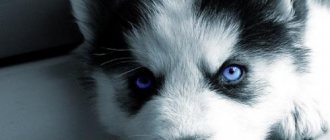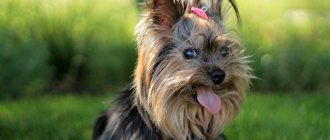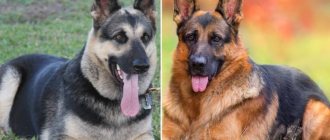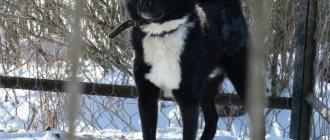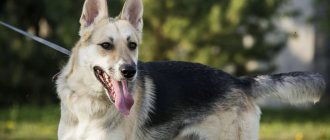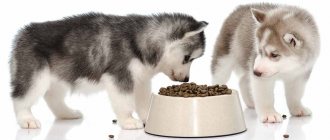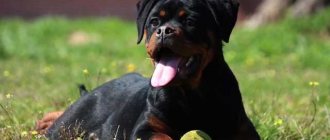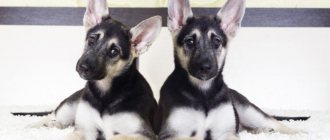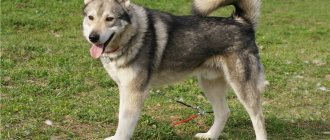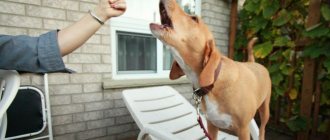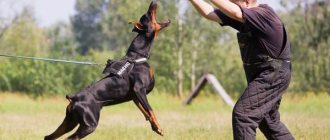If you are a hunter or plan to become one, then when choosing a husky puppy you should pay attention to the month in which he was born. Litters born during the colder months (late fall or winter) will require more effort to raise and may require nutritional supplements (such as vitamin D). Litter born in summer is easier to raise - good weather and plenty of walks in the sun are conducive to this.
However, it is still better for the hunter to choose a winter puppy. And the point here is not in the horoscope: if you take a baby born in winter, you can go hunting with him this coming fall. A summer puppy will miss the season because he will still be too young for professional work.
Collar training
The dog should not be put on a hard collar right away. Initially, at the pet store you need to pick up a wide collar made of soft, fleecy leather.
Many puppies immediately start trying to get rid of the collar. If you notice this in your puppy, you should immediately distract him with some kind of game.
After the collar, you should be accustomed to a leash. Leash training will be much more difficult, because huskies have a strong-willed character. They cannot restrain their movements; they need good coordination of their actions.
Puppies love treats, so when you put on a collar and leash, you can give your pet a treat.
When you put on the leash for the first time, the dog should not be pulled. She needs to be given time to get used to the foreign object.
You need to calm her down, make her understand that even with a leash you are nearby.
Getting used to a leash and collar for huskies takes an average of four to six months.
After a certain time, the dog can be released from the leash in the forest or for a walk. At such a moment, you no longer have to fear that your four-legged friend will run away and not return.
Now you can start practicing commands with your dog.
The main rule to follow is to give your pet freedom of action. Only in this way will she be able to understand how to behave in different situations.
"Near!"
It is necessary to accustom your dog to walking nearby both on a leash and without it, starting from the age of six months. For training, it is advisable to choose a place far from the roadway, where there are few distractions. The dog needs to be put on a short lead. Say: “nearby.” In this case, the dog must be pulled up to the left leg using a leash.
At first, you need to walk next to the dog in a straight line, then you should complicate the route by making turns. Once the dog has learned the command, you can use a long leash and let the animal go long distances. When the dog runs away, you must say the command “near”. If she doesn't listen, then pull the leash. Over time, the leash can be released. When the command is well understood, the leash can be removed.
Basic rules for training
The most important commands that a pet should remember when training are: stand, sit, don’t, come to me, next to me.
These commands must be learned at a young age and at home.
When training, you need to constantly praise the puppy. The voice should be kind, soft and velvety, without irritation.
It is worth remembering that under no circumstances should you shout at the puppy, raise your voice, or even offend him (assault is prohibited, even in a playful manner).
These rules must be followed, otherwise the dog will become timid and nervous. He may lose his appetite and sleep.
She must not feel threatened by you; she must not hear the scream. In this way, you can disrupt the emotional-psychic tone of the dog.
If you see that your dog is apathetic towards training, you should not insist on continuing it. You should give your four-legged friend a break of a few days.
After treating her with a treat, you can try to start training her again.
Training should be done in a playful way, so it will be easier for the puppy to adapt to it.
Squirrel training
The squirrel is the animal with which husky training initially begins.
For huskies, the best hunting time is considered to be from August to November.
At the end of summer, squirrels begin to prepare for the winter period. As a rule, animals not only move along branches, but also on the ground.
Therefore, it is possible to detect squirrel tracks on the ground, which will allow the hunter to quickly find it.
It is important to know that even a young puppy’s hunting instinct awakens when he sees animals. This means that your pet needs to be trained from the age of four months.
The dog needs to be taught to give a signal when it sees an animal running away. She must give voice to her master
An experienced dog handler can be involved in the training to teach the basics. You can then continue training your pet yourself.
You can release your husky for joint training with an experienced relative. The young puppy will adopt all the habits of the older dog and will quickly figure out what needs to be done.
In training, you can also use so-called artificial methods.
An artificial trail is laid to the tree and the already shot carcass of the animal is tied to it. And the dog must be given the command to find the animal and find the squirrel among the branches.
If your pet can skillfully hunt squirrels, then he will easily be able to catch faster animals (sable, marten). Sable and marten are very active animals, but they have a stronger scent for hunting.
How to train a husky to use ammunition
It is best to start training with ammunition with a collar. It does not cause much discomfort to dogs; they quickly get used to it. Puppies are curious and inquisitive, if the baby wants to sniff the collar, there is no need to resist it, let him sniff. Then you need to sit your pet down, put the harness around his neck, fasten it, praise the baby for his endurance, or immediately take him for a walk. If you associate the collar with something positive, very soon the puppy will stick his neck out when he sees it.
After the collar, you can try hooking the leash. Often the hated rope causes a storm of emotions in puppies. They may kick, roll, growl and bite the leash. In this situation, the main thing is to remain calm and distract the dog’s attention from the leash with a treat or toy. Using a metal chain instead of a leash will help wean you from the bad habit of chewing on a leash.
For marten
A young husky needs to be trained starting at the age of ten months, and not earlier. Even if your dog has been trained for squirrel, it is better to let it go for marten for the first time with an experienced dog.
In a pair, the pet will be better able to navigate and understand commands. He will run after an adult hunter and adopt the habits.
A husky will need no more than four such trainings, after which it can be released to hunt martens on its own.
If it is not possible to go hunting with a second experienced pet, then you can train the dog according to your example.
To do this, you need to find the trail of the animal and track it. Next, get the marten yourself and show it to the dog.
The husky has a very well developed memory, so it is enough to show it once or twice how to properly hunt furry animals.
She will immediately understand what is required of her and during the next hunt there will be no problems in catching animals. The puppy himself will track and show the path leading to the animal’s hole.
First commands for a husky puppy
At the age of 4–5 weeks, the little husky is ready to begin training . Most often, the dog begins to learn the basics in the kennel, watching how the breeders interact with the bitch and other animals (if there are any).
Here is a list of commands that a dog must first learn:
- "Place!" (the dog returns to its bedding, usually this command is learned immediately, without much effort);
- "Ugh!" (sharp impact when trying to take food from the ground; following the command cannot be encouraged),
- "It is forbidden!" (a softer version of “Ugh!”);
- "Sit!" (the owner forces the dog to sit or waits for it to sit on its own and rewards it);
- "Lie!" (similar, but the dog takes a lying position);
- "To me!" (the owner calls the dog by name and rewards him when he approaches);
- "Stand!" (stay in a standing position for 10–20 seconds);
- "Voice!";
- "Quiet!";
- “Wait!”;
- "Near!" (the “Near!” command should be taught to the puppy only after he has mastered the leash).
You can teach your husky the command “Walk!” (it is convenient to master it in conjunction with “Near!” - they complement each other. But many owners refuse this command, considering it unnecessary: it is necessary only for service dogs who are on “watch” and do not have the right to leave the place of duty without permission. Laikas can usually roam freely.
If you plan to go hunting with your pet, you will additionally need the following commands:
- "Forward!";
- “Look!”;
- “Take it!”;
- "Give!";
- "Right!" and “Left!”
- "Back!".
Not a single hunt is complete without fetching. Laikas quickly learn to fetch toys and join in this exciting game with pleasure. Dog handlers recommend replacing toys with bones, rags or chicken wings from time to time so that the dog does not have the unwanted association of the “Fetch!” command. with one subject.
On the moose
Training a husky on a large animal puts it under physical strain.
Moose training begins at a more mature age, when the dog is more than two years old.
The pet must track the animal while hunting and drive it towards the hunter or into the so-called settling tank, from where the animal can no longer get out (the edge of a ravine, a rock ledge). For weasels, this is even morally difficult.
This training is suitable for weasels for hunting large animals (deer, rams, roe deer and other artiodactyls).
If you are a small-scale hunter, then there is no point in training your dog to catch large animals.
If you hunt small fur-bearing animals, then such training does not make sense.
Dog handlers do not recommend exposing your affection to physical and emotional stress. Dogs have a human-like experience factor.
Before you begin training, you need to decide for what purposes it will be carried out. For the right decision, consult a professional dog trainer.
On the boar
The hunting season for large wild boars is the most difficult season for training huskies.
The pet must be in good physical shape and in a stable emotional state.
The difficulty is that the dog must be taught not to voice when an animal is detected.
The dog must be taught patience when tracking down prey.
But 300 meters away, the husky must make a voice, which must be furious and angry, so that the animal develops fear and confusion.
A wild boar is an unpredictable animal and can attack not only a person, but also a dog during a hunt.
The pet must understand exactly when to run away. A boar, while barking, may suddenly lunge towards the dog in order to hook its fangs.
The pet must be able to dodge, otherwise injury may occur, which can be fatal.
Remember that not all dogs are designed for hog hunting season.
It is worth paying attention to her hereditary genes and what her descendants did. Only those young puppies whose parents were engaged in similar activities are prepared for hunting large animals.
If training for wild boar does occur, then from childhood the puppy should be accustomed to the smell of wild boar, but not to hunting for them.
Hunting is permitted for pets no earlier than they are two years old.
You can give him pieces of meat from a shot wild boar, or add a few drops of the animal’s blood to drinking water. This can be done from six months.
The main rule for all hunters is to always carry a first aid kit with you.
Hunting large animals for huskies is dangerous due to all kinds of injuries caused. If your pet has the slightest wound, it urgently needs to be treated with an antiseptic and shown to a veterinarian.
Training dogs at home: how to train them correctly
You can learn about the hunting qualities of a puppy only when it is grown up. And training needs to be done from a month and a half. A hunting dog especially needs obedience. She works remotely from her owner and must obey his voice. Unlike service dog breeding, hunters do not adhere to the rules of training standard commands. It is almost impossible to hear the cry of “Ugh!” or the call “Aport!” towards this dog. There is one more nuance that you need to know in advance before you start training your puppy. A good hunting husky has a passion for hunting. She will gladly go to work in the forest not only with the owner, but also with his proxies. Therefore, it is important that the pet understands the commands of the hunters in the area.
Training a husky begins with the commands:
- "To me!";
- "Sit!";
- "Lie!";
- "Place!";
- "It is forbidden!";
- “Take it!”
- "Near!";
- “Look!”;
- "Voice!";
- "Forward!";
- "Stand!";
- “Wait!”;
- "Give!".
All commands are learned through repeated repetition and rewards for completed work. The younger the puppy, the shorter the lesson time.
"To me!"
The dog remembers the command very quickly. It is necessary to call the puppy to you, showing complementary foods, while repeating the command.
"Sit!"
The husky is held by the chest or collar with one hand, pressing on the dog’s croup with the other, forcing the hind legs to bend. The order is repeated several times during coercion.
"Lie!"
From the “sitting” position, the pet is transferred to the “lying” position, pressing on the area of the shoulder blades. Clueless puppies can be pulled on their front legs at the same time, forcing them to lie down. You need to get the puppy to independently carry out this command.
Photo gallery
In our selection of photos, we invite you to familiarize yourself with the main points of teaching dogs hunting skills. Not recommended for viewing by children and people with vulnerable psyches!
